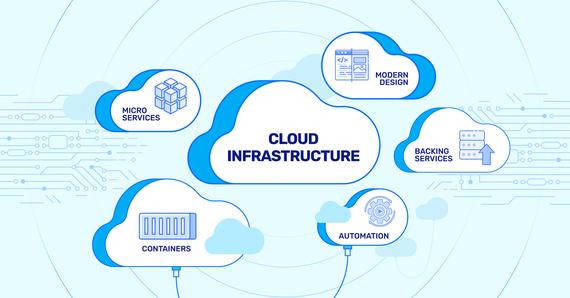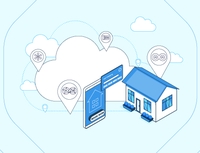
Why Cloud-Native Transformation Should Be a Part of Your Digital Strategy
Digital transformation has reshaped how businesses operate, keeping customers at the forefront. Its urgency …

Today’s borrowers expect a seamless, hassle-free experience with their lenders. More than 80% of potential borrowers now prefer completing the loan application process entirely online, a shift made possible by the transition from traditional, manual methods to digital mortgage lending platforms.
The digital shift has enabled lenders to speed up transactions by efficiently managing digital files and allowing buyers to quickly sign and notarize documents, thereby streamlining closings. This approach is not only cost-effective, reducing paper usage, travel for closings, labor costs, and errors, but it also enhances security with encrypted and protected digital files.
However, transitioning from manual to digital mortgage technology is just the beginning. Using outdated technology still puts lenders at a disadvantage. The slower processes and increased security risks stemming from disparate data sources, coupled with constant upkeep, make these systems difficult to manage. Moreover, the inability to keep pace with changing regulations can result in legal issues for lenders.
The problems don’t stop at legacy systems. Lenders who rely on monolithic architectures for their applications also face significant challenges:
According to a Google survey, 41.4% of global tech and business lenders are planning to increase their investments in cloud-based services and products due to the current economic climate. The study also revealed that 72% of cloud decision-makers view “digital transformation as something more than a simple lift-and-shift exercise where systems are moved from data centers to the cloud”.
Although cloud adoption has been a consideration for lenders for some time, there’s a widespread misconception that simply switching to cloud services will automatically yield benefits such as cost optimization, scalability, and reliability.
Migrating to the cloud without updating legacy or monolithic applications may result in underwhelming savings and could potentially lead to increased costs. Leveraging mortgage digital transformation effectively requires a thorough evaluation of existing systems and their capacity for future expansion.
In the mortgage industry, there’s an urgent need to make processes more efficient, and the constraints of outdated technology and monolithic systems are leading many mortgage lenders to explore more adaptable architectures.
This calls for a revision of application logic, employing modern technologies and methods such as APIs, breaking monolith to microservices, and containerization, to name a few:
Adopting microservices in the mortgage industry means dividing large systems into smaller, independent units. For instance, a separate microservice for loan origination can be updated independently, minimizing disruption. This approach enhances fault tolerance and allows for scaling specific services like loan closing during high-demand periods without affecting the entire system. This flexibility enables lenders to innovate, adapt quickly to market shifts, and provide borrowers with a consistently smooth experience.
Containerization packages software components into isolated containers; it wraps code, libraries, and dependencies into standardized units, ensuring consistent performance across different platforms, from development laptops to cloud environments. This allows for quick updates and seamless feature rollouts in mortgage systems without disrupting workflows. Additionally, it facilitates easy migration of applications between on-premises servers and cloud services, offering greater flexibility than traditional systems.
Implementing DevSecOps for lending ensures early integration of security, significantly reducing system vulnerabilities which is crucial for protecting borrower data. This approach speeds up software deployment, as teams are no longer hindered by extensive waiting periods for tests and risk management checks. DevSecOps helps establish a robust security foundation, critical for maintaining compliance and safeguarding borrower information in an industry where data security is paramount.
CICD practices involve regularly integrating code changes and automatically deploying them to production, allowing for bug fixes and minor enhancements to be deployed multiple times a day. This accelerates software delivery and updates to the mortgage system and improves customer experience. Additionally, integrating compliance and security into the CICD flow ensures adherence to financial regulations, making mortgage lenders more efficient, agile and secure in their operations.
Tailored to the unique requirements of mortgage lenders, our low-code, auto-code generation platform, Compage, facilitates application modernization through the adoption of cloud-native technologies.
IBM Institute of Business Value research showed that 83% of executives view app and data modernization as an important part of their business strategy. ChatGPT’s debut has prompted mortgage lenders to consider the potential of GenAI for the industry.
Exploring GenAI use cases for the mortgage sectors reveals its potential to aid application modernization, offering capabilities such as code generation, reverse engineering, best practices recommendation, auto-healing, and more.
However, the success of GenAI for modernization depends on good quality training data, the expertise of developers in GenAI and Natural Language Processing (NLP) technologies, and the adaptation of outputs to fit business requirements. Integrating GenAI with a platform like Compage, which is adept at generating a secure, business-aligned codebase, can enhance its effectiveness. Compage’s security integrations add to the robustness of the code, and tailoring Compage’s LLM with specific datasets can provide a more rounded experience, combining the strengths of both Compage and GenAI in the mortgage industry.
Interested in discovering how Compage can enhance your mortgage lending business? Contact us to schedule a demo now. You can also check our platform on GitHub and follow us on LinkedIn for the latest updates and insights.

Digital transformation has reshaped how businesses operate, keeping customers at the forefront. Its urgency …

Legacy systems are a major cost driver for organizations, yet many businesses opt to retain these aging …

Businesses that remain stagnant risk falling behind the curve. What was once considered groundbreaking may …
Finding the right talent is pain. More so, keeping up with concepts, culture, technology and tools. We all have been there. Our AI-based automated solutions helps eliminate these issues, making your teams lives easy.
Contact Us